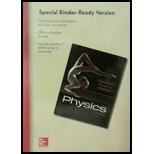
Concept explainers
(a)
Whether the electric field do positive or negative work when the charge
(a)
Answer to Problem 1CQ
The electric field does positive work when the charge
Explanation of Solution
When we move two opposite charges close together, their initial and final kinetic energies will be zero, so the external force does negative work and the electric field does positive work.
Write the expression for the external work.
Here,
Therefore, the electric field does positive work when the charge
(b)
Whether the potential
(b)
Answer to Problem 1CQ
The potential increases as
Explanation of Solution
The expression to find the potential is
Therefore, the potential increases as
(c)
Whether the potential energy decreases or increases.
(c)
Answer to Problem 1CQ
The potential energy decreases.
Explanation of Solution
For charges of opposite signs, the potential energy decreases due to the negative sign in the potential energy term. Thus, the potential energy decreases for two opposite signs approaching each other.
(d)
When the fixed charge is changed to
(d)
Answer to Problem 1CQ
The electric field does negative work, the potential decrease and the potential energy increases.
Explanation of Solution
When the charges are both negative, the electric field is doing negative work, the repulsion of the charges cause the potential to decrease and the potential energy increases.
Therefore, the electric field does negative work, the potential decrease and the potential energy increases.
Want to see more full solutions like this?
Chapter 17 Solutions
Loose Leaf Version For Physics
 College PhysicsPhysicsISBN:9781305952300Author:Raymond A. Serway, Chris VuillePublisher:Cengage Learning
College PhysicsPhysicsISBN:9781305952300Author:Raymond A. Serway, Chris VuillePublisher:Cengage Learning University Physics (14th Edition)PhysicsISBN:9780133969290Author:Hugh D. Young, Roger A. FreedmanPublisher:PEARSON
University Physics (14th Edition)PhysicsISBN:9780133969290Author:Hugh D. Young, Roger A. FreedmanPublisher:PEARSON Introduction To Quantum MechanicsPhysicsISBN:9781107189638Author:Griffiths, David J., Schroeter, Darrell F.Publisher:Cambridge University Press
Introduction To Quantum MechanicsPhysicsISBN:9781107189638Author:Griffiths, David J., Schroeter, Darrell F.Publisher:Cambridge University Press Physics for Scientists and EngineersPhysicsISBN:9781337553278Author:Raymond A. Serway, John W. JewettPublisher:Cengage Learning
Physics for Scientists and EngineersPhysicsISBN:9781337553278Author:Raymond A. Serway, John W. JewettPublisher:Cengage Learning Lecture- Tutorials for Introductory AstronomyPhysicsISBN:9780321820464Author:Edward E. Prather, Tim P. Slater, Jeff P. Adams, Gina BrissendenPublisher:Addison-Wesley
Lecture- Tutorials for Introductory AstronomyPhysicsISBN:9780321820464Author:Edward E. Prather, Tim P. Slater, Jeff P. Adams, Gina BrissendenPublisher:Addison-Wesley College Physics: A Strategic Approach (4th Editio...PhysicsISBN:9780134609034Author:Randall D. Knight (Professor Emeritus), Brian Jones, Stuart FieldPublisher:PEARSON
College Physics: A Strategic Approach (4th Editio...PhysicsISBN:9780134609034Author:Randall D. Knight (Professor Emeritus), Brian Jones, Stuart FieldPublisher:PEARSON





